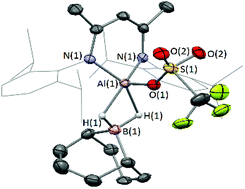Reversible borohydride formation from aluminium hydrides and {H(9-BBN)}2: structural, thermodynamic and reactivity studies†
Abstract
A series of novel β-diketiminate stabilised aluminium borohydrides of the type (Nacnac)Al(R){H2(9-BBN)} has been synthesised offering variation in both the auxiliary R substituent and in the Nacnac backbone itself. A number of these complexes show unusual dissociation of the borane from the aluminium hydride in solution under ambient conditions. The lability of the borane is shown (by variable temperature NMR analyses) to be influenced by the electronic character of both the aluminium-bound R substituent and the Nacnac ligand itself, such that electron-withdrawing substituents lead to greater dissociation of the borane. Comparison of these complexes with related systems featuring the tetrahydroborate [BH4]− ligand illustrates the impact of the boron-bound substituents on the ability of the borane fragment to dissociate from the aluminium hydride. This dissociative behaviour is shown to be highly influential on the ability of the borohydride complexes to reduce carbon dioxide in a stoichiometric manner.

- This article is part of the themed collection: Inorganic chemistry of the p-block elements


 Please wait while we load your content...
Please wait while we load your content...